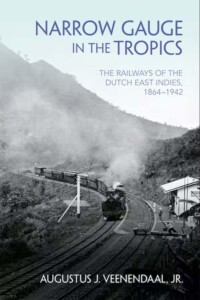
The 310-page book Narrow Gauge in the Tropics is a thorough examination of the railroads in the tropical islands of the Dutch or Netherlands East Indies, capturing the story behind the first railroad in Java where construction began in 1864. Java is the most populous and economically developed of the thousands of the Indian archipelago. There were numerous and seemingly insurmountable problems in the railroad organization and construction, both technical and human. The book, with maps and black-and-white equipment photos, notes detailed construction of the rail lines, but also gives an overview of the initial roster of locomotives and rolling stock, which had to be manufactured and shipped with Germany or England. The equipment was constructed in the European standard gauge, and 9,000 railroad workers were employed to construct the track.
The book further discusses whether there should have been private or state-sponsored railroads organized, a chapter on how the early state railroads functioned, and details of a major crop failure in 1884 and reorganization of the railroads. Following is a chapter of the rail lines on Sumatra, with the first line opening in 1886. In all, this is a well-organized and detailed book that captures the early struggles and successes of railroads in the Dutch East Indies.
By Augustus J. Veenendaal Jr., published by Indiana University Press, Bloomington, Ind., $45.









